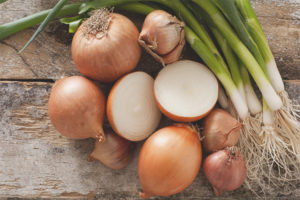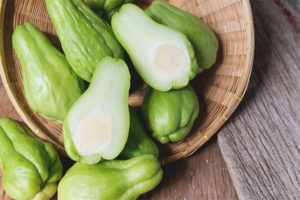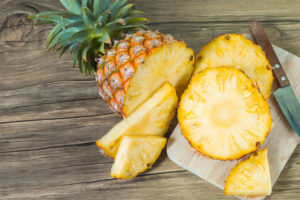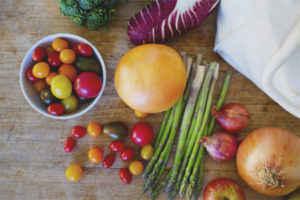The content of the article
Botanists have a protracted debate about whether it is a vegetable or a fruit. The situation recalls the native and beloved pumpkin. The inhabitants of Thailand solved the problem practically, using the pulp of the fruit as a side dish and for making desserts, paying tribute to both directions. Melon-like fruit is popular in the country and sold at every bazaar. The right choice of goodies will allow you to enjoy the whole gamut of taste shades.
Golden beauty from warm countries
Papaya is often called a melon tree for its peculiar appearance and color of the fruit. It’s unusual to see melons not on a melon, but almost above your head, clusters are located at the very top, at a height of 9-10 meters under a luxurious fan of long carved leaves, their length often reaches 70 cm. In the unripe form, the fruits are more like green coconuts, but significantly differ in sizes ranging from 20 to 50 cm.
The plant is of great agricultural importance to southern countries. Mexico and the southern part of America are considered to be considered the homeland, but papaya easily acclimatized in India, China, Ethiopia, Guatemala, Kenya. It is part of many dishes.
Interesting: in green, it is cooked like a vegetable; in ripe, it is referred to as fruit. When baking, the finished dish emits a characteristic smell of freshly baked bread, for which the tree received another name - bread.
Melon trees are grown on special plantations, harvested in protective clothing, since latex juice has strong allergenic properties. The range of application of fruits and leaves is quite wide. They are used in cooking, medicine, cosmetology.
Composition and properties
The unique combination of common and rare elements has created an excellent reputation for papaya. Locals own a huge number of recipes with her as a main component. If you look closely at the list of elements, you will find:
- vitamins;
- alpha and beta carotene;
- lutein;
- lycopene;
- amino acids;
- macro and microelements;
- fatty acid.
The special enzyme papain is able to soften and destroy the coarse fibers of meat. This property is used in medicine for the production of drugs to improve digestion and stabilize well-being with intervertebral osteochondrosis, as a powerful anthelmintic and contraceptive.
The pulp is low-calorie, 100 gr. no more than 45 kcal, which is used in low-calorie diets and weight loss programs.
Fruit selection
The criteria depend on the intended use.
Important: for the preparation of salads, first courses and side dishes choose green papaya, as a dessert - ripe. Papaya begins to bear fruit after six months, its season is extended for the whole year, so you can try it fresh at any time. For ripe fruit, it tastes like some undercooked sweet carrots, while others are more likely to associate with unsweetened melon. Buying the whole fruit for the first test is not profitable. It is large, and the reaction to taste is unpredictable. It is more convenient to conduct a tasting at the buffet in the hotel or to purchase a small tray with papaya already peeled and cut into pieces.
As a souvenir, from the warm edges usually choose slightly ripened fruits. In the green form, they tolerate transportation well, the skin is elastic and perfectly retains the delicate pulp. Completely ripened fruits are soft, deteriorate quickly, and are distinguished by a yellow or bright orange peel. They are eaten fresh, boiled syrups, jam, prepare desserts, added to ice cream and alcoholic cocktails.
In unusual dishes of Thai cuisine, green fruits are used, the most popular in the menu of restaurants of national cuisine are:
- spicy salad There Som;
- papaya and seafood soup;
- sliced meat;
- Ripe pulp dessert with lime juice.
It must be remembered that each product has contraindications. Papaya is not recommended for allergic reactions. It can not be eaten in large quantities, as this is fraught with painful external and internal burns due to latex juice. Another feature is the high content of carpain. It is a weak poison, causing parasites to leave the chosen organism. At high concentrations, it can cause nausea and dizziness. For the papaya, the saying that everything is good in moderation is perfect.
Secrets of a Good Choice
Considering the fruits on the counter, it is worth remembering that their taste depends on the degree of ripeness. To choose a papaya for dessert, you need:
- Pay attention to bright yellow, evenly colored fruits.
- Set aside papaya with dents and black patches.
- The surface should be slightly exposed under the fingers, which indicates ripeness.
Peel the fruit like a melon, cutting off the skin and removing seeds from the middle chamber. After that, cut it into small cubes or slices. In order not to get your hands dirty, eat with a fork. Dried and dried fruit pulp often appears on sale. They are light in weight, stored for a long time, and perfectly tolerate transportation. Selected by bright color, pleasant sweetish smell, smooth surface of the slices.
Interesting properties of papaya directly depend on the degree of ripeness. This must be remembered when proceeding with the selection of the Queen of the Tropics.
How to choose and eat papaya











Submit